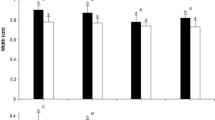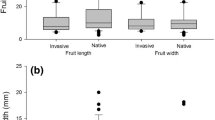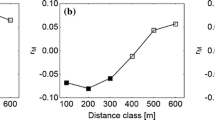Abstract
Variation in traits affecting seed dispersal in plants has been attributed to selection exerted by dispersal agents. The potential for such selection was investigated in Virola calophylla (Myristicaceae) in Manú National Park, Peru, through identification of seed dispersal agents and of tree and fruit traits significantly affecting the quantity of seeds dispersed. Seventeen bird and one primate species (the spider monkey, Ateles paniscus) dispersed its seeds. Spider monkeys dispersed the majority of seeds (a minimum of 83% of all dispersed seeds). Visitation by dispersal agents depended only on the quantity of ripe fruit available during a tree observation. In contrast, seed removal increased with both greater quantity of ripe fruit and aril: seed ratio. When analyzed separately, seed removal by birds increased only with greater aril: seed ratio, whereas seed removal by spider monkeys was affected by the quantity of ripe fruit and phenological stage. The finding that dispersal agents responded differently to some tree and fruit traits indicates not only that dispersal agents can exert selection on traits affecting seed dispersal, but also that the resulting selection pressures are likely to be inconsistent. This conclusion is supported by the result that the proportion of the seed crop that was dispersed from individual trees, which accounted for cumulative dispersal by all agents, was not influenced by any tree or fruit trait evaluated. Comparing these results with those from studies of V. sebifera and V. nobilis in Panama revealed that the disperser assemblages of these three Virola species were congruent in their similar taxonomic representation. In Panama the proportion of V. nobilis seed crop dispersed was related positively to aril: seed ratio and negatively to seed mass, a result not found for V. calophylla in Peru. The greater importance of dispersal by primates versus birds in V. calophylla, relative to V. nobilis, may explain this difference. Thus, variation in disperser assemblages at regional scales can be another factor contributing to inconsistency in disperser-mediated selection on plant traits.

Similar content being viewed by others
References
Benkman CW (1995) The impact of tree squirrels (Tamiasciurus) on limber pine seed dispersal adaptations. Evolution 49:585–592
Bleher B, Bohning-Gaese K (2001) Consequences of frugivore diversity for seed dispersal, seedling establishment, and the spatial pattern of seedlings and trees. Oecologia 129:385–394
Bourne GR (1974) The red-billed toucan in Guyana. The Living Bird 13:99–126
Campbell CJ (2000) The reproductive biology of black-handed spider monkeys (Ateles geoffroyi): Integrating behavior and endocrinology. Ph.D. thesis, University of California, Berkeley
Carlo TA, Collazo JA, Groom MJ (2003) Avian fruit preferences across a Puerto Rican forested landscape: pattern consistency and implications for seed removal. Oecologia 134:119–131
Chapman CA, Chapman LJ (2002) Plant-animal coevolution: is it thwarted by spatial and temporal variation in animal foraging? In: Levey DJ, Silva WR, Galetti M (eds) Seed dispersal and frugivory: ecology, evolution, and conservation. CABI, New York, pp 275–290
Comins HN, Hamilton WD, May RM (1980) Evolutionarily stable dispersal strategies. J Theor Biol 82:205–230
Davidar P, Morton ES (1986) The relationship between fruit crop sizes and fruit removal rates by birds. Ecology 67:262–265
Dew JL (2001) Synecology and seed dispersal in woolly monkeys (Lagothrix lagotricha poeppigii) and spider monkeys (Ateles belzebuth belzebuth) in Parque Nacional Yasuní, Ecuador. Ph.D. thesis, University of California, Davis
Eriksson O, Ehrlen J (1998) Phenological adaptations in fleshy vertebrate-dispersed fruits of temperate plants. Oikos 82:617–621.
Falconer DS (1991) Quantitative genetics. Longman, New York
Forget P, Sabatier D (1997) Dynamics of the seedling shadow of a frugivore-dispersed tree species in French Guiana. J Trop Ecol 13:767–773
Foster MS (1990a) Factors influencing bird foraging preferences among conspecific fruit trees. Condor 92:844–854
Foster RB (1990b) The floristic composition of the Rio Manú Floodplain Forest. In: Gentry AH (ed) Four neotropical forests. Yale University Press, New Haven, pp 99–111
Galetti M, Laps R, Pizo MA (2000) Frugivory by toucans (Ramphastidae) at two altitudes in the Atlantic forest of Brazil. Biotropica 32:842–850
Gautier-Hion A, Gautier J-P, Maisels F (1993) Seed dispersal versus seed predation: an intersite comparison of two related African monkeys. Vegetatio 107/108:237–244
Gentry AH (1990) Four neotropical forests. Yale University Press, New Haven
Giannini R, Bellari C (1995) Heritability estimate of seed germination parameters in Pinus leucodermis Antoine. Seed Sci Technol 23:385–392
Gryj EO, Dominguez GA (1996) Fruit removal and postdispersal survivorship in the tropical dry forest shrub Erythroxylum havanense: ecological and evolutionary implications. Oecologia 108:368–374
Guillotin M, Dubost G, Sabatier D (1994) Food choice and food competition among the three major primate species of French Guiana. J Zool 233:551–579
Hamilton WD, May RM (1977) Dispersal in stable habitats. Nature 269:578–581
Hardner C, Winks C, Russ S, Gallagher E (2001) Genetic parameters for nut and kernel traits in macadamia. Euphytica 117:151–161
Harrowven DC, Newman NA, Knight CA (1998) On the identity of a neo-lignan from the fruits of Virola sebifera. Tetrahedron Lett 39:6757–6760
Herrera CM (1985) Determinants of plant-animal coevolution: the case of mutualistic dispersal of seeds by vertebrates. Oikos 44:132–141
Howe HF (1977) Bird activity and seed dispersal of a tropical wet forest tree. Ecology 58:539–550
Howe HF (1981) Dispersal of a neotropical nutmeg (Virola sebifera) by birds. Auk 98:88–98
Howe HF (1984) Constraints on the evolution of mutualisms. Am Nat 123:764–777
Howe HF, Richter WM (1982) Effects of seed size on seedling size in Virola surinamensis; a within and between tree analysis. Oecologia 53:347–351
Howe HF, Vande Kerckhove GA (1979) Fecundity and seed dispersal of a tropical tree. Ecology 60:180–189
Howe HF, Vande Kerckhove GA (1980) Nutmeg dispersal by tropical birds. Science 210:925–927
Howe HF, Vande Kerckhove GA (1981) Removal of wild nutmeg (Virola surinamensis) crops by birds. Ecology 62:1093–1106
Janzen DH, Martin PS (1982) Neotropical anachronisms: The fruits the gomphotheres ate. Science 215:19–27
Jordano P (1995) Angiosperm fleshy fruits and seed dispersers: a comparative of adaptation and constraints in plant-animal interactions. Am Nat 145:163–191
Korine C, Kalko EKV, Herre EA (2000) Fruit characteristics and factors affecting fruit removal in a Panamanian community of strangler figs. Oecologia 123:560–568
Lemus SM, Castro O (1989) Potential antifungal neolignans from Virola koschnyi fruits. Spectrosc Int J 7:353–358
Lord JM, Markey AS, Marshall J (2002) Have frugivores influenced the evolution of fruit traits in New Zealand? In: Levey DJ, Silva WR, Galetti M (eds) Seed dispersal and frugivory: ecology, evolution, and conservation. CABI, New York, pp 55–68
Manasse RS, Howe HF (1983) Competition for dispersal agents among tropical trees: influences of neighbors. Oecologia 59:185–190
Matziris D (1998) Genetic variation in cone and seed characteristics in a clonal seed orchard of Aleppo pine grown in Greece. Silvae Genet 47:37–41
McKey D (1975) The ecology of coevolved seed dispersal systems. In: Gilbert LE, Raven PH (eds) Coevolution of animals and plants. University of Texas, Austin, pp 159–191
Milton K (1993) Diet and social organization of a free-ranging spider monkey population: the development of species-typical behavior in the absence of adults. In: Pererira ME, Fairbanks LA (eds) Juvenile primates: life history, development, and behavior. Oxford University Press, Oxford, pp 136–144
Murray KG (1987) Selection for optimal fruit crop size in bird-dispersed plants. Am Nat 129:18–31
Parciak W (2002) Seed size, number, and habitat of a fleshy-fruited plant: consequences for seedling establishment. Ecology 83:794–808
Ribeiro JELS, Hopkins MJG, Vicentini A, Sothers CA, Costa MAS, de Brito JM, de Souza MAD, et al (1999) Flora da Reserva Ducke: Guia de intentificação das plantas vasculares de uma floresta de terra-firme na Amazônia Central. INPA-DFID, Manaus
Robinson WD, Brawn JD, Robinson SK (2000) Forest bird community structure in central Panama: Influence of spatial scale and biogeography. Ecol Monogr 70:209–235
Rodrigues WA (1980) Revisao taxonomica das especies de Virola Aublet (Myristicaceae) do Brasil. Acta Amazon 10:1-127
Sallabanks R (1993) Hierarchical mechanisms of fruit selection by an avian frugivore. Ecology 74:1326–1336
Sargent S (1990) Neighborhood effects on fruit removal by birds: a field experiment with Viburnum dentatum (Caprifoliaceae). Ecology 71:1289–1298
SAS (2000) The SAS System Release 8.1. SAS Institute, Cary, N.C.
Schupp EW (1993) Quantity, quality, and the effectiveness of seed dispersal by animals. Vegetatio 107/108:15–29
Shaw RG, T Mitchell-Olds (1993) ANOVA for unbalanced data: an overview. Ecology 74:1638–1645
Snow DW (1971) Evolutionary aspects of fruit-eating by birds. Ibis 113:194–202
Stevenson PR, Quinones MJ, Ahumada JA (2000) Influence of fruit availability on ecological overlap among four neotropical primates at Tinigua National Park, Colombia. Biotropica 32:533–544
Stiles EW (1980) Patterns of fruit presentation and seed dispersal in bird-disseminated woody plants in the eastern deciduous forest. Am Nat 116:670–688
Terborgh J (1983) Five new world primates. Princeton University Press, Princeton, N.J.
Terborgh J, Robinson SK, Parker TA III, Munn C, Pierpont N (1990) Structure and organization of an Amazonian forest bird community. Ecol Monogr 60:213–238
Thompson JN (1999) Specific hypotheses on the geographic mosaic of coevolution. Am Nat 153:S1-S14
Thompson JN, Willson MF (1979) Evolution of temperate fruit/bird interactions: phenological strategies. Evolution 33:973–982
van Roosmalen MGM (1985a) Fruits of the Guianan Flora. Institute of Systematic Botany, Utrecht University, and Silvicultural Department of Wageningen Agricultural University, Wageningen
van Roosmalen MGV (1985b) Habitat preferences, diet, feeding strategy, and social organization of the black spider monkey (Ateles paniscus paniscus Linnaeus 1758) in Surinam. Acta Amazon 15:1-238
Wheelwright NT, Orians GH (1982) Seed dispersal by animals: contrasts with pollen dispersal, problems of terminology, and constraints on coevolution. Am Nat 119:402–413
Yao Q, Mehlenbacher SA (2000) Heritability, variance components and correlation of morphological and phenological traits in hazelnut. Plant Breeding 119:369–381
Acknowledgements
This research was supported by a Pre-doctoral Fellowship from the National Science Foundation, a Research Award from the American Ornithologists' Union, and a Clark Research Grant and a Dissertation Travel Grant from the University of Illinois. The Instituto Nacionál de Recursos Naturales in Peru graciously granted permission to conduct this research. I thank my graduate committee, Carol K. Augspurger, Scott K. Robinson, George O. Batzli, Jeffrey D. Brawn, and Stephen Portnoy for their mentorship. Jeffrey D. Brawn, Mercedes S. Foster, Henry F. Howe, and Thomas J. Near provided stimulating discussions of this research. I thank Mark Gardiner, Luis Alza Leon, Timothy Paine, and Edwin Salazar Zapata for tireless assistance in the field. Susanne Aref provided important help with statistical analyses. I thank Thomas J. Near for his support and encouragement.
Author information
Authors and Affiliations
Corresponding author
Rights and permissions
About this article
Cite this article
Russo, S.E. Responses of dispersal agents to tree and fruit traits in Virola calophylla (Myristicaceae): implications for selection. Oecologia 136, 80–87 (2003). https://doi.org/10.1007/s00442-003-1239-y
Received:
Accepted:
Published:
Issue Date:
DOI: https://doi.org/10.1007/s00442-003-1239-y




